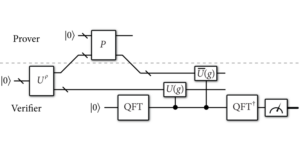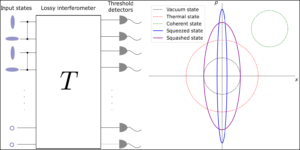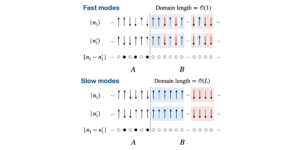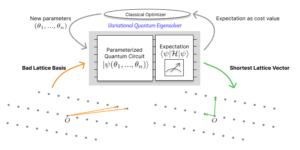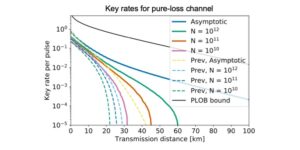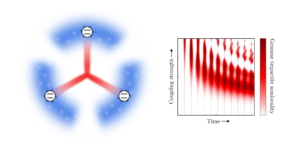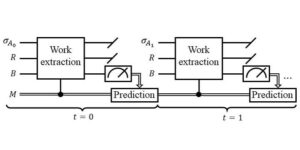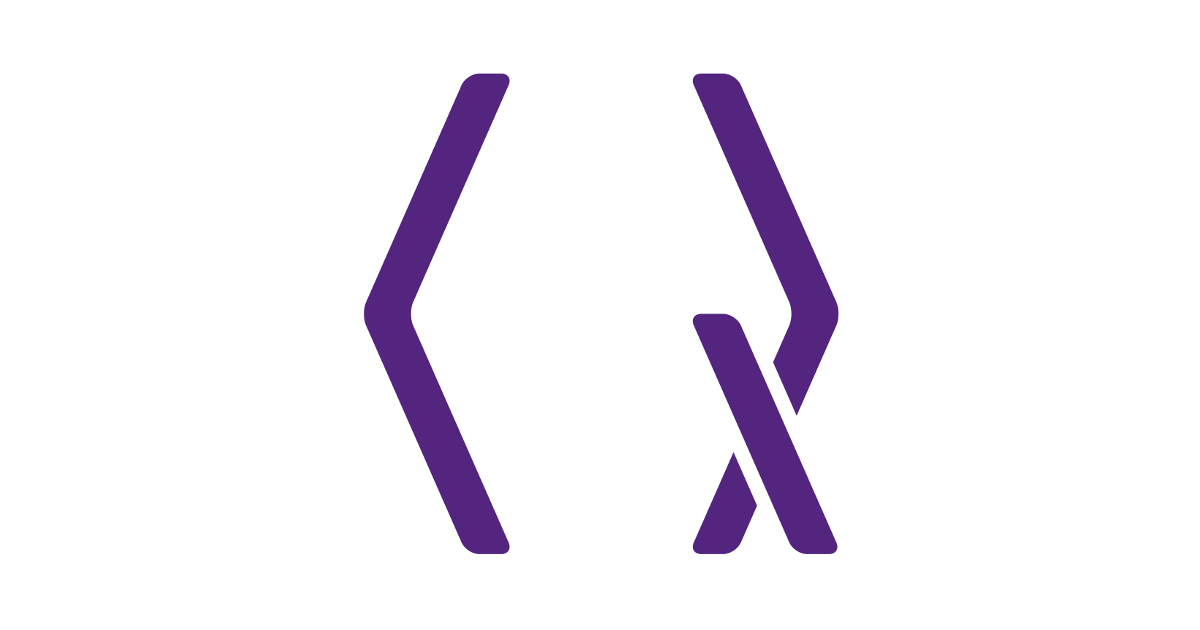
1QOLS, Blackett Laboratory, Imperial College London SW7 2AZ, UK
2Philippe Meyer Institute, Physics Department, École Normale Supérieure (ENS), Université PSL, 24 rue Lhomond, F-75231 Paris, France
Find this paper interesting or want to discuss? Scite or leave a comment on SciRate.
Abstract
We study different aspects of the stabilizer entropies (SEs) and compare them against known nonstabilizerness monotones such as the min-relative entropy and the robustness of magic. First, by means of explicit examples, we show that, for Rényi index $0leq nleq2$, the SEs are not monotones with respect to stabilizer protocols which include computational-basis measurements, not even when restricting to pure states (while the question remains open for $ngeq2$). Next, we show that, for any Rényi index, the SEs do not satisfy a strong monotonicity condition with respect to computational-basis measurements. We further study SEs in different classes of many-body states. We compare the SEs with other measures, either proving or providing numerical evidence for inequalities between them.
Finally, we discuss exact or efficient tensor-network numerical methods to compute SEs of matrix-product states (MPSs) for large numbers of qubits. In addition to previously developed exact methods to compute the Rényi SEs, we also put forward a scheme based on perfect MPS sampling, allowing us to compute efficiently the von Neumann SE for large bond dimensions.
► BibTeX data
► References
[1] Scott Aaronson and Daniel Gottesman. Improved simulation of stabilizer circuits. Phys. Rev. A, 70: 052328, Nov 2004. 10.1103/PhysRevA.70.052328.
https://doi.org/10.1103/PhysRevA.70.052328
[2] Hussain Anwar, Benjamin J Brown, Earl T Campbell, and Dan E Browne. Fast decoders for qudit topological codes. New J. Phys., 16 (6): 063038, 2014. 10.1088/1367-2630/16/6/063038.
https://doi.org/10.1088/1367-2630/16/6/063038
[3] Michael Beverland, Earl Campbell, Mark Howard, and Vadym Kliuchnikov. Lower bounds on the non-clifford resources for quantum computations. Quantum Science Tech., 5 (3): 035009, 2020. 10.1088/2058-9565/ab8963.
https://doi.org/10.1088/2058-9565/ab8963
[4] Sergey Bravyi and Alexei Kitaev. Universal quantum computation with ideal clifford gates and noisy ancillas. Phys. Rev. A, 71: 022316, Feb 2005. 10.1103/PhysRevA.71.022316.
https://doi.org/10.1103/PhysRevA.71.022316
[5] Sergey Bravyi, Dan Browne, Padraic Calpin, Earl Campbell, David Gosset, and Mark Howard. Simulation of quantum circuits by low-rank stabilizer decompositions. Quantum, 3: 181, 2019. 10.22331/q-2019-09-02-181.
https://doi.org/10.22331/q-2019-09-02-181
[6] Kaifeng Bu and Dax Enshan Koh. Efficient classical simulation of clifford circuits with nonstabilizer input states. Phys. Rev. Lett., 123: 170502, Oct 2019. 10.1103/PhysRevLett.123.170502.
https://doi.org/10.1103/PhysRevLett.123.170502
[7] Kaifeng Bu, Roy J Garcia, Arthur Jaffe, Dax Enshan Koh, and Lu Li. Complexity of quantum circuits via sensitivity, magic, and coherence. arXiv:2204.12051, 2022. URL https://doi.org/10.48550/arXiv.2204.12051.
https://doi.org/10.48550/arXiv.2204.12051
arXiv:2204.12051
[8] Earl T. Campbell. Catalysis and activation of magic states in fault-tolerant architectures. Phys. Rev. A, 83: 032317, Mar 2011. 10.1103/PhysRevA.83.032317.
https://doi.org/10.1103/PhysRevA.83.032317
[9] Earl T. Campbell. Enhanced fault-tolerant quantum computing in $d$-level systems. Phys. Rev. Lett., 113: 230501, Dec 2014. 10.1103/PhysRevLett.113.230501.
https://doi.org/10.1103/PhysRevLett.113.230501
[10] Earl T. Campbell, Hussain Anwar, and Dan E. Browne. Magic-state distillation in all prime dimensions using quantum reed-muller codes. Phys. Rev. X, 2: 041021, Dec 2012. 10.1103/PhysRevX.2.041021. URL https://doi.org/10.1103/PhysRevX.2.041021.
https://doi.org/10.1103/PhysRevX.2.041021
[11] Earl T Campbell, Barbara M Terhal, and Christophe Vuillot. Roads towards fault-tolerant universal quantum computation. Nature, 549 (7671): 172–179, 2017. 10.1038/nature23460.
https://doi.org/10.1038/nature23460
[12] Liyuan Chen, Roy J Garcia, Kaifeng Bu, and Arthur Jaffe. Magic of random matrix product states. arXiv:2211.10350, 2022. URL https://doi.org/10.48550/arXiv.2211.10350.
https://doi.org/10.48550/arXiv.2211.10350
arXiv:2211.10350
[13] Eric Chitambar and Gilad Gour. Quantum resource theories. Rev. Mod. Phys., 91: 025001, Apr 2019. 10.1103/RevModPhys.91.025001. URL https://doi.org/10.1103/RevModPhys.91.025001.
https://doi.org/10.1103/RevModPhys.91.025001
[14] J Ignacio Cirac, David Perez-Garcia, Norbert Schuch, and Frank Verstraete. Matrix product density operators: Renormalization fixed points and boundary theories. Ann. Phys., 378: 100–149, 2017. 10.1016/j.aop.2016.12.030.
https://doi.org/10.1016/j.aop.2016.12.030
[15] J Ignacio Cirac, David Perez-Garcia, Norbert Schuch, and Frank Verstraete. Matrix product states and projected entangled pair states: Concepts, symmetries, theorems. Rev. Mod. Phys., 93 (4): 045003, 2021. 10.1103/RevModPhys.93.045003.
https://doi.org/10.1103/RevModPhys.93.045003
[16] Bryan Eastin and Emanuel Knill. Restrictions on transversal encoded quantum gate sets. Phys. Rev. Lett., 102: 110502, Mar 2009. 10.1103/PhysRevLett.102.110502.
https://doi.org/10.1103/PhysRevLett.102.110502
[17] Glen Evenbly. A practical guide to the numerical implementation of tensor networks i: Contractions, decompositions, and gauge freedom. Frontiers in Applied Mathematics and Statistics, 8: 806549, 2022. 10.3389/fams.2022.806549.
https://doi.org/10.3389/fams.2022.806549
[18] Andrew J. Ferris and Guifre Vidal. Perfect sampling with unitary tensor networks. Phys. Rev. B, 85: 165146, Apr 2012. 10.1103/PhysRevB.85.165146.
https://doi.org/10.1103/PhysRevB.85.165146
[19] Daniel Gottesman. Stabilizer codes and quantum error correction. Caltech Ph. D. PhD thesis, Thesis, eprint: quant-ph/9705052, 1997. URL https://doi.org/10.48550/arXiv.quant-ph/9705052.
https://doi.org/10.48550/arXiv.quant-ph/9705052
arXiv:quant-ph/9705052
[20] Daniel Gottesman. The heisenberg representation of quantum computers. arXiv quant-ph/9807006, 1998a. URL https://doi.org/10.48550/arXiv.quant-ph/9807006.
https://doi.org/10.48550/arXiv.quant-ph/9807006
arXiv:quant-ph/9807006
[21] Daniel Gottesman. Theory of fault-tolerant quantum computation. Phys. Rev. A, 57: 127–137, Jan 1998b. 10.1103/PhysRevA.57.127.
https://doi.org/10.1103/PhysRevA.57.127
[22] Oliver Hahn, Alessandro Ferraro, Lina Hultquist, Giulia Ferrini, and Laura García-Álvarez. Quantifying qubit magic resource with gottesman-kitaev-preskill encoding. Phys. Rev. Lett., 128: 210502, May 2022. 10.1103/PhysRevLett.128.210502.
https://doi.org/10.1103/PhysRevLett.128.210502
[23] Oliver Hahn, Alessandro Ferraro, Lina Hultquist, Giulia Ferrini, and Laura García-Álvarez. Erratum: Quantifying qubit magic resource with gottesman-kitaev-preskill encoding [phys. rev. lett. 128, 210502 (2022)]. Phys. Rev. Lett., 131: 049901, Jul 2023. 10.1103/PhysRevLett.131.049901.
https://doi.org/10.1103/PhysRevLett.131.049901
[24] Tobias Haug and M.S. Kim. Scalable measures of magic resource for quantum computers. PRX Quantum, 4: 010301, Jan 2023. 10.1103/PRXQuantum.4.010301.
https://doi.org/10.1103/PRXQuantum.4.010301
[25] Tobias Haug and Lorenzo Piroli. Quantifying nonstabilizerness of matrix product states. Phys. Rev. B, 107 (3): 035148, 2023. 10.1103/PhysRevB.107.035148.
https://doi.org/10.1103/PhysRevB.107.035148
[26] Tobias Haug, Soovin Lee, and MS Kim. Efficient stabilizer entropies for quantum computers. arXiv:2305.19152, 2023. URL https://doi.org/10.48550/arXiv.2305.19152.
https://doi.org/10.48550/arXiv.2305.19152
arXiv:2305.19152
[27] Arne Heimendahl, Markus Heinrich, and David Gross. The axiomatic and the operational approaches to resource theories of magic do not coincide. J. Math. Phys., 63 (11): 112201, 2022. 10.1063/5.0085774.
https://doi.org/10.1063/5.0085774
[28] Mark Howard and Earl Campbell. Application of a resource theory for magic states to fault-tolerant quantum computing. Phys. Rev. Lett., 118: 090501, Mar 2017. 10.1103/PhysRevLett.118.090501.
https://doi.org/10.1103/PhysRevLett.118.090501
[29] Jiaqing Jiang and Xin Wang. Lower bound for the t count via unitary stabilizer nullity. Physical Review Applied, 19 (3): 034052, 2023. 10.1103/PhysRevApplied.19.034052.
https://doi.org/10.1103/PhysRevApplied.19.034052
[30] A Yu Kitaev. Fault-tolerant quantum computation by anyons. Ann. Phys., 303 (1): 2–30, 2003. 10.1016/S0003-4916(02)00018-0.
https://doi.org/10.1016/S0003-4916(02)00018-0
[31] Guglielmo Lami and Mario Collura. Quantum magic via perfect sampling of matrix product states. arXiv:2303.05536, 2023. URL https://doi.org/10.48550/arXiv.2303.05536.
https://doi.org/10.48550/arXiv.2303.05536
arXiv:2303.05536
[32] Lorenzo Leone, Salvatore F. E. Oliviero, and Alioscia Hamma. Stabilizer rényi entropy. Phys. Rev. Lett., 128: 050402, Feb 2022. 10.1103/PhysRevLett.128.050402.
https://doi.org/10.1103/PhysRevLett.128.050402
[33] Lorenzo Leone, Salvatore F. E. Oliviero, Gianluca Esposito, and Alioscia Hamma. Phase transition in stabilizer entropy and efficient purity estimation. arXiv:2302.07895, 2023a. URL https://doi.org/10.48550/arXiv.2302.07895.
https://doi.org/10.48550/arXiv.2302.07895
arXiv:2302.07895
[34] Lorenzo Leone, Salvatore F. E. Oliviero, and Alioscia Hamma. Nonstabilizerness determining the hardness of direct fidelity estimation. Phys. Rev. A, 107: 022429, Feb 2023b. 10.1103/PhysRevA.107.022429.
https://doi.org/10.1103/PhysRevA.107.022429
[35] Zi-Wen Liu and Andreas Winter. Many-body quantum magic. PRX Quantum, 3: 020333, May 2022. 10.1103/PRXQuantum.3.020333.
https://doi.org/10.1103/PRXQuantum.3.020333
[36] Michael A. Nielsen and Isaac L. Chuang. Quantum Computation and Quantum Information: 10th Anniversary Edition. Cambridge University Press, 2011. ISBN 9781107002173. doi:10.1017/CBO9780511976667.
[37] J Odavić, T Haug, G Torre, A Hamma, F Franchini, and SM Giampaolo. Complexity of frustration: a new source of non-local non-stabilizerness. arXiv:2209.10541, 2022. URL https://doi.org/10.48550/arXiv.2209.10541.
https://doi.org/10.48550/arXiv.2209.10541
arXiv:2209.10541
[38] Salvatore F. E. Oliviero, Lorenzo Leone, and Alioscia Hamma. Magic-state resource theory for the ground state of the transverse-field ising model. Phys. Rev. A, 106: 042426, Oct 2022a. 10.1103/PhysRevA.106.042426.
https://doi.org/10.1103/PhysRevA.106.042426
[39] Salvatore F. E. Oliviero, Lorenzo Leone, Alioscia Hamma, and Seth Lloyd. Measuring magic on a quantum processor. npj Quantum Information, 8 (1): 148, 2022b. 10.1038/s41534-022-00666-5.
https://doi.org/10.1038/s41534-022-00666-5
[40] Salvatore FE Oliviero, Lorenzo Leone, Seth Lloyd, and Alioscia Hamma. Black hole complexity, unscrambling, and stabilizer thermal machines. arXiv:2212.11337, 2022c. URL https://doi.org/10.48550/arXiv.2212.11337.
https://doi.org/10.48550/arXiv.2212.11337
arXiv:2212.11337
[41] D Perez-Garcia, F Verstraete, MM Wolf, and JI Cirac. Matrix product state representations. Quantum Inf. Comp., 7 (5): 401–430, 2007. 10.26421/QIC7.5-6-1.
https://doi.org/10.26421/QIC7.5-6-1
[42] John Preskill. Fault-tolerant quantum computation. In Introduction to quantum computation and information, pages 213–269. World Scientific, 1998. 10.1142/9789812385253_0008.
https://doi.org/10.1142/9789812385253_0008
[43] Bartosz Regula. Convex geometry of quantum resource quantification. J. Phys. A: Math. Theor., 51 (4): 045303, 2017. 10.1088/1751-8121/aa9100.
https://doi.org/10.1088/1751-8121/aa9100
[44] Saubhik Sarkar, Chiranjib Mukhopadhyay, and Abolfazl Bayat. Characterization of an operational quantum resource in a critical many-body system. New J. Phys., 22 (8): 083077, 2020. 10.1088/1367-2630/aba919.
https://doi.org/10.1088/1367-2630/aba919
[45] James R. Seddon, Bartosz Regula, Hakop Pashayan, Yingkai Ouyang, and Earl T. Campbell. Quantifying quantum speedups: Improved classical simulation from tighter magic monotones. PRX Quantum, 2: 010345, Mar 2021. 10.1103/PRXQuantum.2.010345.
https://doi.org/10.1103/PRXQuantum.2.010345
[46] Troy J Sewell and Christopher David White. Mana and thermalization: Probing the feasibility of near-clifford hamiltonian simulation. Phys. Rev. B, 106 (12): 125130, 2022. 10.1103/PhysRevB.106.125130.
https://doi.org/10.1103/PhysRevB.106.125130
[47] Peter W Shor. Fault-tolerant quantum computation. In Proceedings of 37th conference on foundations of computer science, pages 56–65. IEEE, 1996. 10.1109/SFCS.1996.548464.
https://doi.org/10.1109/SFCS.1996.548464
[48] Pietro Silvi, Ferdinand Tschirsich, Matthias Gerster, Johannes Jünemann, Daniel Jaschke, Matteo Rizzi, and Simone Montangero. The tensor networks anthology: Simulation techniques for many-body quantum lattice systems. SciPost Phys. Lect. Notes, page 8, 2019. 10.21468/SciPostPhysLectNotes.8.
https://doi.org/10.21468/SciPostPhysLectNotes.8
[49] Emanuele Tirrito, Poetri Sonya Tarabunga, Gugliemo Lami, Titas Chanda, Lorenzo Leone, Salvatore FE Oliviero, Marcello Dalmonte, Mario Collura, and Alioscia Hamma. Quantifying non-stabilizerness through entanglement spectrum flatness. arXiv:2304.01175, 2023. URL https://doi.org/10.48550/arXiv.2304.01175.
https://doi.org/10.48550/arXiv.2304.01175
arXiv:2304.01175
[50] Xhek Turkeshi, Marco Schirò, and Piotr Sierant. Measuring magic via multifractal flatness. arXiv:2305.11797, 2023. URL https://doi.org/10.48550/arXiv.2305.11797.
https://doi.org/10.48550/arXiv.2305.11797
arXiv:2305.11797
[51] Victor Veitch, SA Hamed Mousavian, Daniel Gottesman, and Joseph Emerson. The resource theory of stabilizer quantum computation. New J. Phys., 16 (1): 013009, 2014. 10.1088/1367-2630/16/1/013009.
https://doi.org/10.1088/1367-2630/16/1/013009
[52] Xin Wang, Mark M Wilde, and Yuan Su. Quantifying the magic of quantum channels. New J. Phys., 21 (10): 103002, 2019. 10.1088/1367-2630/ab451d.
https://doi.org/10.1088/1367-2630/ab451d
[53] Christopher David White, ChunJun Cao, and Brian Swingle. Conformal field theories are magical. Phys. Rev. B, 103: 075145, Feb 2021. 10.1103/PhysRevB.103.075145.
https://doi.org/10.1103/PhysRevB.103.075145
Cited by
[1] Poetri Sonya Tarabunga, Emanuele Tirrito, Titas Chanda, and Marcello Dalmonte, “Many-body magic via Pauli-Markov chains — from criticality to gauge theories”, arXiv:2305.18541, (2023).
[2] Emanuele Tirrito, Poetri Sonya Tarabunga, Gugliemo Lami, Titas Chanda, Lorenzo Leone, Salvatore F. E. Oliviero, Marcello Dalmonte, Mario Collura, and Alioscia Hamma, “Quantifying non-stabilizerness through entanglement spectrum flatness”, arXiv:2304.01175, (2023).
[3] Xhek Turkeshi, Marco Schirò, and Piotr Sierant, “Measuring Magic via Multifractal Flatness”, arXiv:2305.11797, (2023).
[4] Guglielmo Lami and Mario Collura, “Quantum Magic via Perfect Pauli Sampling of Matrix Product States”, arXiv:2303.05536, (2023).
[5] Junjie Chen, Yuxuan Yan, and You Zhou, “Magic of quantum hypergraph states”, arXiv:2308.01886, (2023).
[6] Oliver Hahn, Alessandro Ferraro, Lina Hultquist, Giulia Ferrini, and Laura García-Álvarez, “Erratum: Quantifying Qubit Magic Resource with Gottesman-Kitaev-Preskill Encoding [Phys. Rev. Lett. 128, 210502 (2022)]”, Physical Review Letters 131 4, 049901 (2023).
[7] Tobias Haug, Soovin Lee, and M. S. Kim, “Efficient stabilizer entropies for quantum computers”, arXiv:2305.19152, (2023).
[8] Davide Rattacaso, Lorenzo Leone, Salvatore F. E. Oliviero, and Alioscia Hamma, “Stabilizer entropy dynamics after a quantum quench”, arXiv:2304.13768, (2023).
The above citations are from SAO/NASA ADS (last updated successfully 2023-08-29 02:14:22). The list may be incomplete as not all publishers provide suitable and complete citation data.
On Crossref’s cited-by service no data on citing works was found (last attempt 2023-08-29 02:14:21).
This Paper is published in Quantum under the Creative Commons Attribution 4.0 International (CC BY 4.0) license. Copyright remains with the original copyright holders such as the authors or their institutions.
- SEO Powered Content & PR Distribution. Get Amplified Today.
- PlatoData.Network Vertical Generative Ai. Empower Yourself. Access Here.
- PlatoAiStream. Web3 Intelligence. Knowledge Amplified. Access Here.
- PlatoESG. Automotive / EVs, Carbon, CleanTech, Energy, Environment, Solar, Waste Management. Access Here.
- PlatoHealth. Biotech and Clinical Trials Intelligence. Access Here.
- ChartPrime. Elevate your Trading Game with ChartPrime. Access Here.
- BlockOffsets. Modernizing Environmental Offset Ownership. Access Here.
- Source: https://quantum-journal.org/papers/q-2023-08-28-1092/
- :is
- :not
- 1
- 10
- 10th
- 11
- 12
- 13
- 14
- 15%
- 16
- 17
- 19
- 1996
- 1998
- 20
- 2005
- 2011
- 2012
- 2014
- 2016
- 2017
- 2019
- 2020
- 2021
- 2022
- 2023
- 22
- 23
- 24
- 25
- 26%
- 27
- 28
- 30
- 31
- 32
- 33
- 36
- 39
- 40
- 49
- 50
- 51
- 7
- 70
- 8
- 9
- 91
- a
- above
- ABSTRACT
- access
- Activation
- addition
- affiliations
- After
- against
- All
- Allowing
- also
- an
- and
- Andrew
- Anniversary
- any
- Application
- applied
- approaches
- apr
- ARE
- Arthur
- AS
- aspects
- Aug
- author
- authors
- based
- BE
- Benjamin
- between
- Black
- Black Hole
- bond
- Bound
- boundary
- bounds
- Break
- Brian
- brown
- Bryan
- by
- cambridge
- chains
- channels
- chen
- Christopher
- classes
- codes
- College
- comment
- Commons
- COMP
- compare
- complete
- complexity
- computation
- computations
- Compute
- computer
- computer science
- computers
- computing
- concepts
- condition
- Conference
- Convex
- copyright
- critical
- criticality
- Daniel
- data
- David
- Department
- determining
- developed
- different
- dimensions
- direct
- discuss
- do
- dynamics
- e
- edition
- efficient
- efficiently
- either
- enhanced
- ENS
- entanglement
- error
- Even
- evidence
- examples
- FAST
- Feb
- fidelity
- field
- First
- fixed
- For
- Forward
- found
- Foundations
- frank
- Freedom
- from
- Frontiers
- frustration
- further
- Gates
- gauge
- gross
- Ground
- guide
- harvard
- holders
- Hole
- HTTPS
- i
- ideal
- IEEE
- Imperial
- Imperial College
- Imperial College London
- implementation
- improved
- in
- include
- index
- inequalities
- information
- input
- Institute
- institutions
- interesting
- International
- Introduction
- james
- Jan
- JavaScript
- John
- journal
- Kim
- known
- laboratory
- large
- Last
- Leave
- Lee
- Li
- License
- List
- London
- lower
- Machines
- magic
- MANA
- Marco
- mario
- mark
- math
- mathematics
- Matrix
- May..
- means
- measurements
- measures
- measuring
- methods
- Meyer
- Michael
- model
- Month
- MS
- Nature
- networks
- New
- next
- no
- Notes
- numbers
- Oct
- of
- on
- open
- operational
- operators
- or
- original
- Other
- page
- pages
- pair
- Paper
- paris
- perfect
- Peter
- phase
- phd
- physical
- Physics
- Pietro
- plato
- Plato Data Intelligence
- PlatoData
- points
- Practical
- press
- previously
- Prime
- Proceedings
- Processor
- Product
- projected
- protocols
- provide
- providing
- PSL
- published
- publisher
- publishers
- put
- Quantum
- quantum computers
- quantum computing
- quantum error correction
- quantum gate
- quantum information
- Qubit
- qubits
- question
- R
- random
- references
- remains
- representation
- resource
- Resources
- respect
- restricting
- restrictions
- review
- robustness
- roy
- s
- SA
- scalable
- scheme
- Science
- scientific
- scott
- scott aaronson
- Sensitivity
- Sets
- Shor
- show
- simulation
- Source
- Spectrum
- State
- States
- statistics
- strong
- Study
- Successfully
- such
- suitable
- system
- Systems
- tech
- techniques
- that
- The
- their
- Them
- theory
- thermal
- thesis
- this
- Through
- tighter
- Title
- to
- towards
- transition
- under
- Universal
- university
- updated
- URL
- us
- using
- via
- volume
- von
- W
- want
- was
- we
- when
- which
- while
- white
- Winter
- with
- Wolf
- works
- world
- X
- year
- You
- Yuan
- zephyrnet


